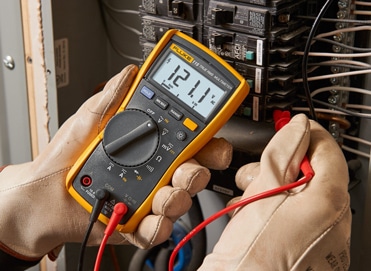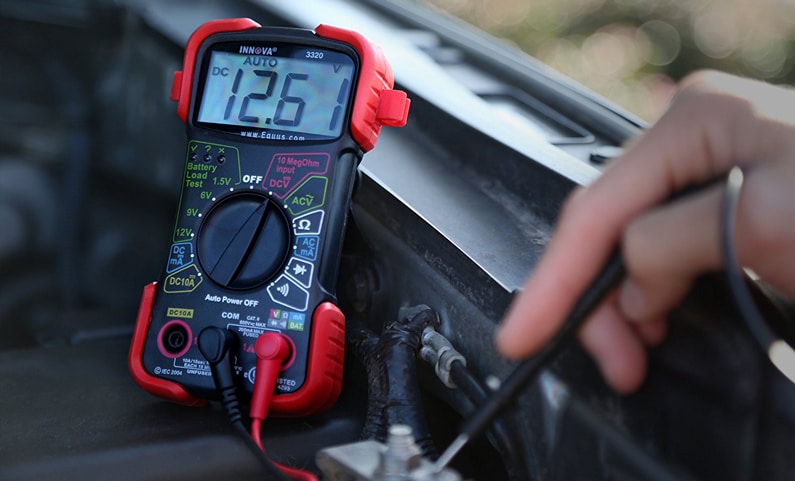
What’s a Multimeter and Why Do I Need One?
A digital multimeter (DMM) is one of the most versatile measurement tools in existence, and an absolute necessity when it comes to electronics. It allows its user to understand what’s happening in the circuits of a particular appliance or a machine. When something is not working right, a multimeter is there to assist the user with the troubleshooting.
The fact that they’re so helpful for detecting electrical faults makes these gadgets suitable for a variety of industries. Almost every experienced electrician uses one when troubleshooting problems with power supplies, wiring systems, appliances, and circuits. Furthermore, DMMs are commonly found in the toolboxes of automotive technicians, who use them to check the electrical components on cars.
There are a plethora of reasons for which a person would want to use one of these devices. Let’s see what the most common purposes are:
- Current measurements
- DC current measurements
- Voltage measurements
- Capacity
- Frequency
- Decibels
- Internal temperature
- Resistance (constant voltage)
- Resistance (constant current)
Parts of a Multimeter
Every single one of these devices consists of three primary elements:
- Display
- Selection knob
- Ports
The unit’s screen usually shows four digits, and it can also display negative signs when required. Some models come with illuminated screens, and these are quite helpful when working in poorly lit areas (such as beneath the car).
The selection knob (or dial), on the other hand, is the part with which the user can set the device to read different measurements, like milliamps (mA), voltage (V), as well as resistance (Ω) and other values.
The ports, which are typically on the lower part of the facade, are where the probes are plugged into. Most models come with two probes – one is red, and the other is black.

Measuring Voltage
Measuring AC or DC voltage is undoubtedly one of the most common uses for a multimeter. It is, in fact, one of the first things new users want to learn how to do. As someone who doesn’t know a lot about these things, you might be worried about selecting the correct voltage setting.
Fortunately, that’s not such a big deal – your gadget will simply display number 1, which is the error that occurs once you overload the DMM. You will, instead, want to select the voltage that’s higher than the one you plan to measure.
Let’s check out which steps one needs to take when measuring the voltage of a battery:
- Plug the probes into COM and mAVΩ (black into COM, red into mAVΩ).
- Set the device to “2V” in the DC range.
- Connect the black probe with the battery’s “-,” and the red probe with “+.”
- Apply some pressure against the battery’s terminals and gently squeeze the probes.
- In case you’re testing a new battery, the display will indicate 1.5 volts or higher.
Measuring Current
If your model has a clamp-style amp, this process will be very easy. All you’ll have to do is to set the knob to amperage, put the clamp over the line, and read the results on display.
On the other hand, if your DMM does not have a clamp-style amp, follow these steps:
- Take out the VCC wire (the one that leads into the unit) and add an extra piece of wire at the place where it was connected. After that, probe from the power pin to the resistor.
- Insert your DMM in-line, therefore allowing it to measure the current that’s flowing through the board.
- Put the selector knob to the right setting and measure the current.

Measuring Resistance
Make sure to set your DMM to the ohms (the “Ω” symbol) and select the required range. After that, follow these steps:
- Take a random resistor and set your DMM to 20kΩ.
- Hold the unit’s probes against the legs of the resistor while applying some gentle pressure.
- Your device should read one of the following things: 1, 0.00, or the value of the resistor.
- If it reads 1, it means that it’s overloaded, which will require you to select a higher mode. If it shows 0.00, you’ll have to lower the mode to 200Ω or 2kΩ.
Continuity Testing
This testing refers to measuring the resistance that takes place between two points. To get started, do take the following steps:
- Set your device to continuity mode – look for the symbol that looks like a speaker.
- Connect the probes to each other. It should cause the DMM to produce a tone.
- Turn off the system before you proceed to continuity testing.
- Poke two separate ground pins with your probes – an appearance of a tone will indicate a connection. After that, poke the probes from a VCC pin on a micro-controller to the VCC situated on the PS (power supply). The appearance of a tone signifies that the power flows freely to the micro-controller. No sound means that there’s a break in the breadboard, the line, or the wire.
Learning how to test the voltage, current, resistance, and continuity should be enough to get you started. Of course, there are many other values you can measure with a multimeter, although that depends on your particular model.
Don’t forget to avoid taking measurements in humid environments, and make sure to wear protective equipment such as the headwear, gloves, and insulated rubber mats. Electricity is a dangerous thing, so make sure to always use your DMM with all the necessary safety concerns in mind.
The post The Best Way to Use a Multimeter – Beginner’s Guide appeared first on Tool Nerds.
from Tool Nerds https://ift.tt/2Jdyo9c
via IFTTT
No comments:
Post a Comment